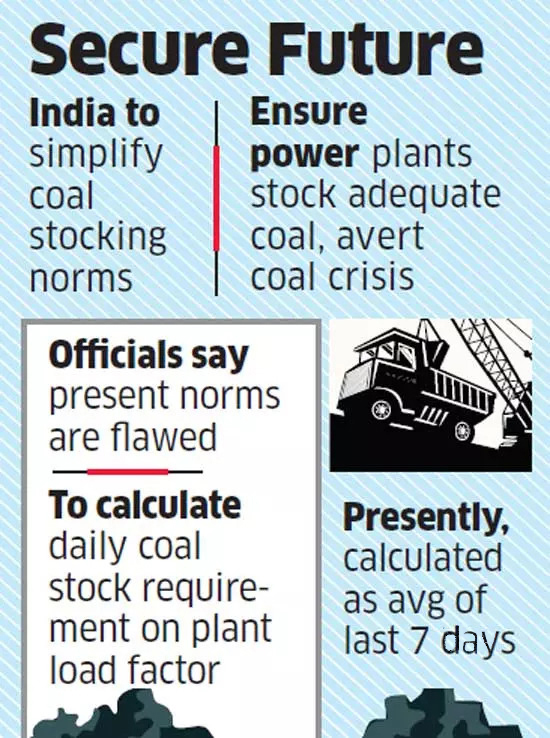Revised Coal Stocking Norms | 10 Dec 2021
Why in News
Recently, the Central Electricity Authority (CEA) has revised Coal Stocking Norms at thermal power generation plants with an aim to prevent a repeat of the low coal stock situation at various plants.
- CEA is an organization under the Electricity Act, 2003. Its objective is to formulate a National Electricity Plan every five years for optimum utilization of available resources for power generation.
Key Points
- Background:
- In October 2021, India’s thermal power plants faced a severe coal shortage, whereby coal stocks had come down to an average of four days of fuel across an increasing number of thermal stations.
- A sharp uptick in demand, a rise in the price of imported coal, and low coal procurement by power stations prior to the monsoon contributed to the low stock situation.
- This was one of the biggest coal crises in India, impacting the slowdown of economic reopening and some businesses’ downscale production.
- The low coal stock situation had forced a number of states to purchase power on the energy exchange, bidding up the average market clearing price of power to Rs 16.4 per unit in October, prompting the government to revise Coal Stocking Norms.
- Previous Norms:
- It mandated 15-30 days of coal stock based on the distance of the plant from the source of coal.
- Earlier, power plants located at pit head plants were required to keep 15 days of coal stock, while the requirement increased to 20 days for plants located within 200 km from the mines, 25 days for those within 1,000 km and 30 days for plants situated further away from the mines.
- Revised Norms:
- It mandates the coal stock of 17 days at pit head stations and 26 days at non-pit head stations to be maintained by power plants from February to June every year.
- Non-pit head plants are power plants where the coal mine is more than 1,500 km away.
- The daily coal requirement at the power plant at any given day will be calculated based on 85% Plant Load Factor (PLF).
- The previous norms determined coal stock volumes according to the average consumption pattern of the plant over the last seven days at a minimum 55% PLF.
- PLF is the ratio between the actual energy generated by the plant to the maximum possible energy that can be generated with the plant working at its rated power and for a duration of an entire year.
- The new methodology implies power plants which have lower utilisation rates will need to stock more coal than they did earlier.
- Power plants will have to strictly follow these parameters, failing which penalties will be levied — an aspect that was not present in CEA regulations so far.
- It mandates the coal stock of 17 days at pit head stations and 26 days at non-pit head stations to be maintained by power plants from February to June every year.
- Significance:
- It will prevent a situation like the one that faced the country recently when post monsoons, several of the 135 coal-based power plants in the country were found to be sitting with critical coal stock levels sufficient to meet just three to four days of supply.
- Relaxed coal stocking norms will also better distribution the fuel amongst generating stations.
- This will prevent shortages and ensure uninterrupted power supply irrespective of the demand situation in the country.
- It will also lower the fuel requirement for each power plant and enable better distribution amongst all stations.
Coal
- It is one of the most abundantly found fossil fuels. It is used as a domestic fuel, in industries such as iron and steel, steam engines and to generate electricity. Electricity from coal is called thermal power.
- The coal which we are using today was formed millions of years ago when giant ferns and swamps got buried under the layers of earth. Coal is therefore referred to as Buried Sunshine.
- The leading coal producers of the world include China, US, Australia, Indonesia, India.
- The coal producing areas of India include Raniganj, Jharia, Dhanbad and Bokaro in Jharkhand.
- Coal is also classified into four ranks: anthracite, bituminous, subbituminous, and lignite. The ranking depends on the types and amounts of carbon the coal contains and on the amount of heat energy the coal can produce.

